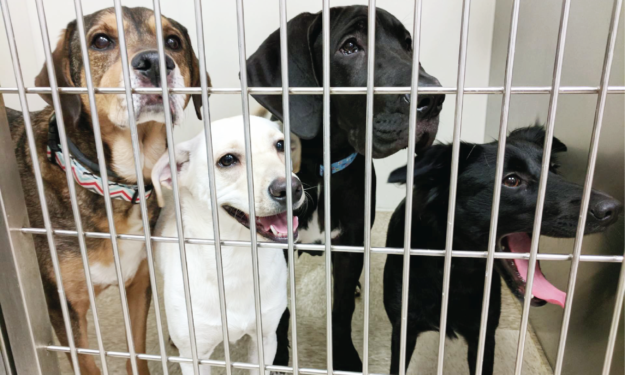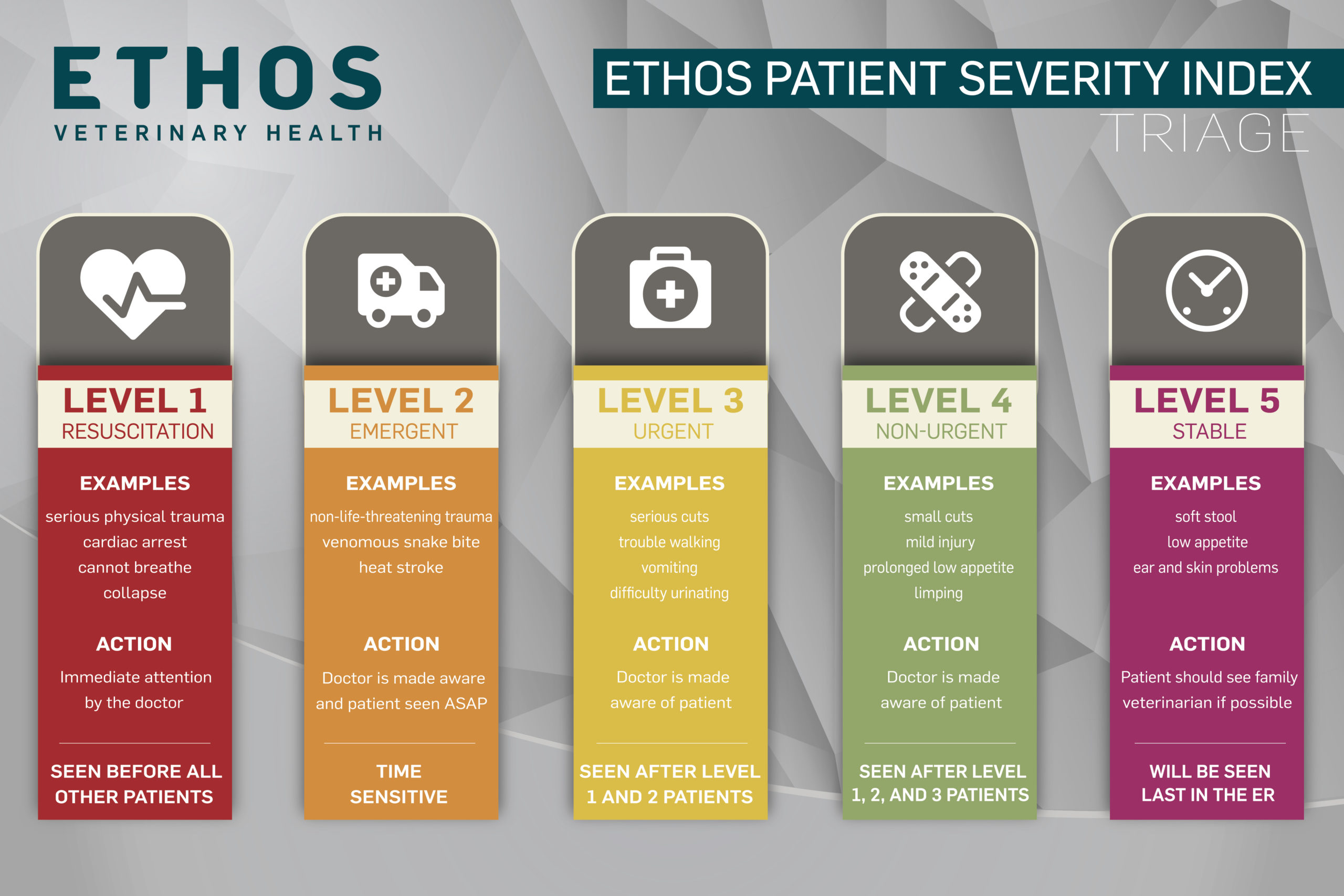Pet Emergencies: What Can and Can’t Wait

Cats and dogs can have a variety of symptoms that may or may not need immediate evaluation and treatment by a veterinarian. It is helpful to know which cases need to be seen right away vs. which ones can wait until the next day or until an appointment can be made with their primary care veterinarian.
Please note:
- This list is not exhaustive, nor can any one pet be definitively diagnosed based on one-line descriptions as provided below.
- Before making any determination to keep your pet home or to bring them to the ER, please call a veterinarian for advice (or Poison Control when appropriate).
- It is always better to err on the side of caution. If you are at all concerned that your pet needs to be seen despite the possible minor or benign symptoms that are being described, never hesitate to just bring your pet to be seen at an emergency veterinary hospital.
Go to the ER
The following symptoms are possible signs of a true emergency and should be evaluated by a veterinarian right away.
1. Trouble Breathing
- Defined as a respiratory rate of 50 breaths per minute or greater that is NOT panting
- Open-mouth breathing in a cat is always considered an emergency
- Exaggerated, loud, or noisy breathing in brachycephalic cats or dogs that is new (smushy-faced breeds)
- Abdominal heaving noted with every breath
- Neck extended to breathe
2. Weakness, Staggering, Shaking, & Mobility Issues
- Sudden and profound weakness or collapse
- Inability to walk or suddenly staggering as if drunk or unsteady on their feet, sudden trouble going up or down the stairs
- Acting disoriented and/or mentally “off” or inappropriate
- Shaking abnormally, restless, pacing, inability to get comfortable or rest
- Seizures or tremors
- Sudden limping or loss of motor function in one or more limbs – ESPECIALLY in a cat
3. Inappropriate Urinating, Defecating, Diarrhea, and Vomiting
- Straining to defecate or urinate- ESPECIALLY in male cats
- No urinations noted in more than 24 hours
- Diarrhea that has progressed to pure liquid, blood, or black and has happened 2 or more times in 24 hours with loss of appetite and/or decreased energy and/or vomiting
- Retching/trying to vomit without producing anything; or distension of the abdomen where it is noticeably larger and more firm and/or tense than usual
- Vomiting 3 or more times in a 24 hour period with loss of appetite and/or decreased energy and/or concurrent diarrhea
4. Bleeding, Wounds, & Trauma
- Ongoing bleeding- ESPECIALLY bleeding that occurs with every heartbeat (i.e. spurting)
- Bite or puncture wounds along the neck, chest, or abdomen
- Severe trauma such as being hit by a car, falling from a high surface, being stepped on
5. Abnormal Appearances or Behavior (Skin, Gums, Eyes, and Noises)
- White or blue gums in presence of acting lethargic or weak
- Sudden appearance of bruises along the body without any history of trauma
- Excruciating pain or vocalizing
- Facial swelling or hives
- Bulging eyes or sudden blindness
- Squinting eyes suddenly
- Fever at home (temperature > 102.8) in presence of other symptoms (ie lethargy, anorexia for > 24 hours, etc.)
6. Suspected Exposure to any Toxin or Medication
Always call Poison Control first!
- Xylitol – dogs
- Lilies – cats
- Grapes/raisins – dogs
- Chocolate (dose dependent) – cats and dogs
- Antifreeze – cats and dogs
- Insulin overdose
- Over the counter OR prescribed medication that has not been specifically prescribed for your pet – call Poison Control for advice on whether pet needs to be seen
- human medications such as Tylenol (acetaminophen) can be safe for humans but deadly for cats
- Rodenticide/rat poison
May Be Safe to Wait for Appointment
The following are symptoms that MAY be safe to wait until morning to see your regular vet or an urgent care vet, or can see an emergency hospital if the symptoms have not improved by the next day.
CAUTION: no single symptom can be universally be defined as a true emergency or non-emergency without a veterinarian to evaluate the patient directly. If you are at all concerned or unsure of how serious your pet’s symptoms may be, always err on the side of caution and have them evaluated sooner than later.
- Coughing without signs of labored breathing and able to rest (i.e. cough is not affecting quality of life at home)
- Sneezing, runny nose
- Not eating anything for less than 24 hours
- Vomiting once or twice within 24 hours but acting normal
- One or two episodes of diarrhea within 24 hours but acting normal
- Limping (NOTE- some forms of lameness are more serious than others, espeically in adult cats, so please call a veterinarian depending on more specific details pertaining to your pet at the time)
- Itchy skin or ears, or thickness/fluid pocket within an ear
Can Be Safely Monitored at Home
Some symptoms can be safely monitored at home, treated at home, or can wait several days to see a veterinarian. Again, this list is not exhaustive, and sometimes seemingly minor symptoms can be a sign of a more serious problem. Please always ask the advice of a veterinarian prior to making decisions about waiting to have your pet seen. Below is a list of symptoms that have more specific recommendations based on condition:
- Torn toenail with minor to no bleeding
- Small wound or abrasion
- New lumps or bumps identified on your pet (that do not resemble hives which is an emergency)
- Ticks found on your pet – this does NOT need to be seen by a veterinarian and can be gently removed via tweezers
- Fleas
- Worms seen in stool in absence of other clinical signs (especially in puppies, kittens, and outdoor cats)
You know your pet and if you see anything out of the ordinary, please don’t hesitate to call or go to your veterinarian or the nearest ER. We hope you won’t need our ER services but if you do, we are here.
Know Before You Go
Below is our Patient Severity Index that our emergency teams use when evaluating & triaging a patient and determining which pets must be seen first. Pets at Level 1 would be seen immediately, and pets at Level 5 will likely experience longer wait times at the ER.
